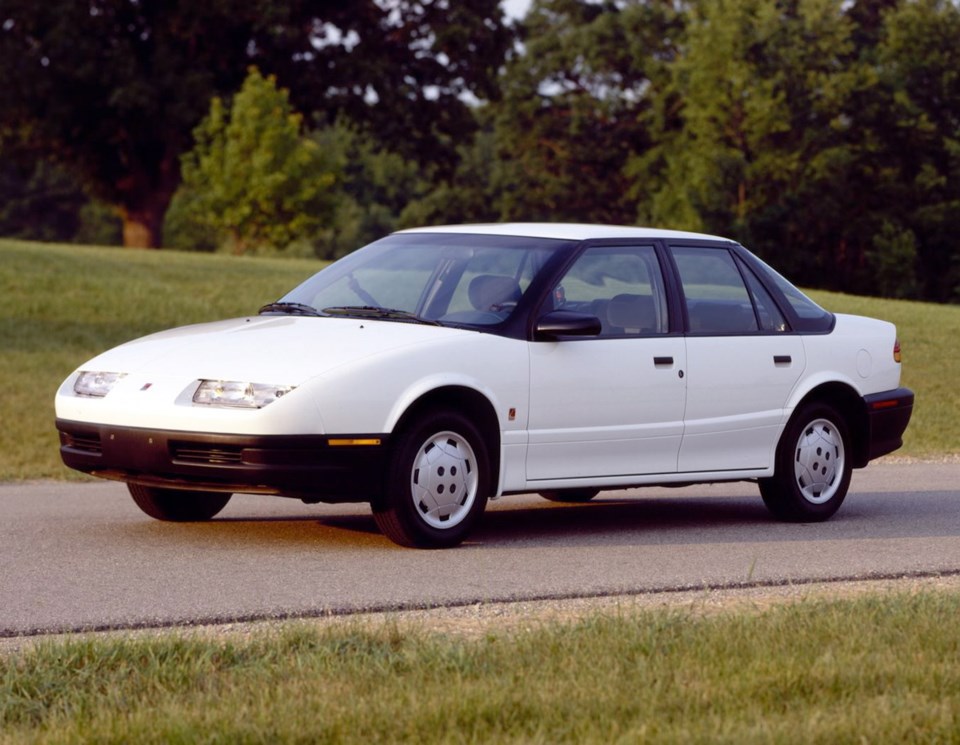It seemed to be an acknowledgement of the obvious. GM and the American auto industry had not staunched the flow of popular imports such as the Honda Civic and Toyota Corolla from dominating North America’s small car market.
So it was a determined Roger Smith, General Motors chairman, who faced the media at GM’s Tech Center in Warren, Michigan in 1985 and made a bold statement: GM would build a new small car “fully competitive with the best of the imports … the key to GM’s long-term competitiveness, survival and success as a domestic producer.”
The car with Smith’s weighty mandate was the Saturn, GM’s fourth attempt at repulsing the invasion. GM called it “a different kind of car from a different kind of car company.”
GM’s first try was the Volkswagen-inspired 1960s Chevrolet Corvair with its air-cooled rear engine. It faded after Ralph Nader’s 1965 book Unsafe At Any Speed declared its handling dangerously because its weight distribution made it unstable and swing axles let the rear wheels “tuck under,” causing low-speed rollovers.
The widely touted small 1971 Chevrolet Vega suffered a faltering launch due to a long, acrimonious labour strike. When it finally reached buyers, its aluminum-block, iron-head engine proved noisy and prone to a variety of problems.
GM tried again in 1981 with the small Chevrolet Cavalier, Pontiac J2000 et al, called J-cars. While sound and well-built, they lacked the refinement of the better imports. Many were sold, but the foreigners kept coming, some, ironically, now North American-built.
So a lot rode on Saturn’s shoulders, a $3-billion US gamble on an autonomous sixth GM division making a brand-new car in a greenfield plant in Spring Hill, Tennessee, far from Detroit bureaucracy. A dedicated dealer network would feature a no-haggle sales policy.
Fresh management philosophy required a new groundbreaking GM-UAW labour agreement that gave all staff a salary and the authority to stop the assembly line if a problem occurred.
Saturn engineers designed the car and its production, applying lessons learned in the GM-Toyota New United Motor Manufacturing Inc. joint venture in Fremont, California. While all existing GM components were available, Saturn’s engineers used almost none.
To beat the competition, you target the best, and Saturn engineers made no secret that their benchmark was the Honda Civic. For simplicity, there would initially be a sedan and a coupe in just two trim levels. A wagon would arrive a year later.
The engine was a Saturn-designed and -manufactured all-aluminum 1.9-litre inline four in two versions with chain-driven overhead camshafts: an 85-horsepower eight-valve, single cam with throttle-body fuel injection, and a 123-horsepower 16-valve twin cam with superior port injection.
Power went to the front wheels through a Saturn-built five-speed manual or four-speed automatic transmission.
Suspension was MacPherson strut front, and struts, coil springs and lateral links rear, with front and rear anti-roll bars. Steering was rack-and-pinion.
Styling was pleasant but not dramatic, with traces of its GM heritage. It had unit construction, and fenders, doors, bumpers and front and rear body panels were plastic, à la the Pontiac Fiero, providing rust protection, easier styling updates and resistance to small dents. Roof, deck and hood were steel.
The first Saturn SL, a 1991 model, was driven off the Spring Hill assembly line by Roger Smith and UAW president Owen Bieber in July 1990. While some skeptics thought GM had bitten off too much — new car, new plant, new workforce, new dealer network — the Saturn proved popular with buyers. It arrived in sa���ʴ�ý a year later.
When assessed by independent testers, the Saturn’s performance did not disappoint. Car and Driver recorded zero to 100 km/h in 8.2 seconds and top speed of 200 km/h for the twin-cam, manual-transmission sedan, competitive with small-car rivals. But they found the engine noisy.
Although falling somewhat short of sales predictions, Saturn was still enthusiastically received. By 1995, production reached a million cars, and by 1999, two million.
Saturn stayed in the small segment until 2000, when it added the LX series sedan and wagon to challenge midsize cars such as the Honda Accord and Toyota Camry. Its European Opel Vectra influences included suspension design and optional Opel V-6.
In 2000, the Saturn experiment began dissolving and its independence started slipping away. In 2002, the GM-designed Saturn Vue crossover arrived, followed in 2005 by the Saturn Relay minivan, sister of the Pontiac Montana et al. The 2007 Saturn Sky sports car was a Pontiac Solstice clone. Saturn was gradually being drawn into GM’s corporate orbit.
The Saturn-UAW special agreement was discontinued in 2004. After an abortive attempt to sell Saturn to Penske Automotive Group, Saturn production ended in 2009, the year the Great Recession caused GM to declare bankruptcy and apply for a government bailout.



